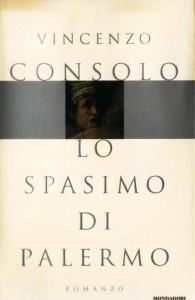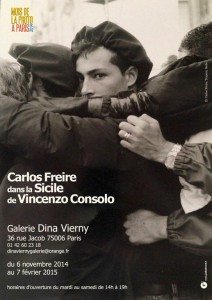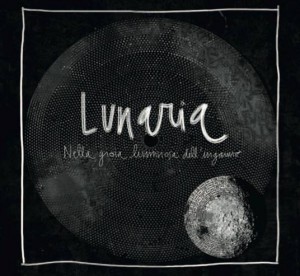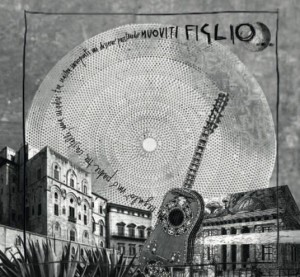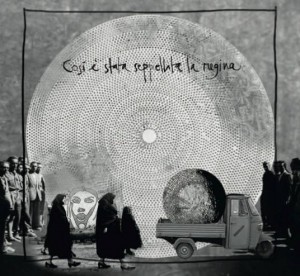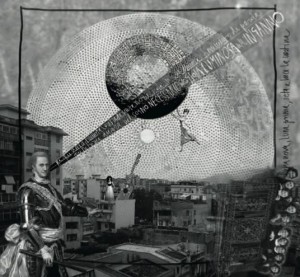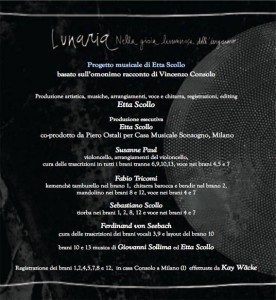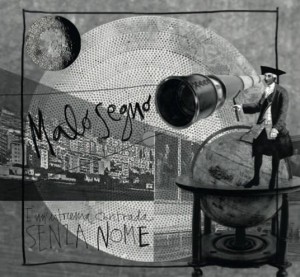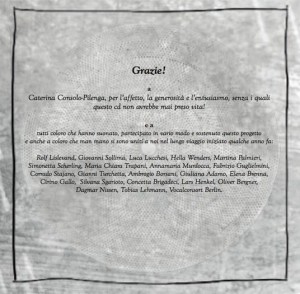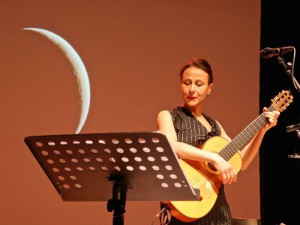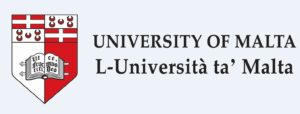Autore: admin
Retablo, Consolo
Consolo, Retablo
Rosalia. Rosa e lia. Rosa che ha inebriato, rosa che ha confuso, rosa che ha sventato, rosa che ha roso, il mio cervello s’è mangiato. Rosa che non è rosa, rosa che è datura, gelsomino, balico e viola…Rosa che punto m’ha, ahi!, con la sua spina velenosa in su nel cuore.
“Retablo” è un termine spagnolo che serve a designare una grande pala d’altare che può essere un dittico o un trittico e che è caratterizzato da una grande complessità di materiali e stili figurativi. Nessuna definizione migliore per questo romanzo, che è un piccolo gioiello per stile, temi e suggestioni sapientemente organizzati su un intreccio di diversi piani narrativi. Due (meglio sarebbe dire tre, forse) i protagonisti. Ambientato nel Settecento, è la storia dell’aristocratico pittore Fabrizio Clerici, che fugge da Milano e dall’amata donna Teresa per perdersi in un fantasmagorico viaggio in Sicilia, e del suo casuale compagno di viaggio, il frate siciliano Isidoro, che ha perso tutto a causa della travolgente passione per la popolana Rosalia. E proprio Rosalia, uno degli oggetti del romanzo, sarà colei che, a sorpresa, darà la chiave per comprendere (avere la visione d’insieme di) questo Retablo, questa composizione.
Grande parte del romanzo è occupata dal diario del Clerici, che annota le caratteristiche delle bellezze della Sicilia, meravigliato dall’inestimabile valore delle opere dell’antichità classica che ovunque si impongono allo sguardo ed ai sensi. Ma questo diario non è solo una collezione di appunti, ma anche, e soprattutto, una lunga e pacata dichiarazione d’amore (deluso) per donna Teresa, e poi un’occasione per riflettere sui rapporti fra arte e vita, fra verità e menzogna, fra l’aspirazione ad una pace superiore e l’incredibile tragicità dell’esistenza, fra l’aspirazione alla serenità e l’attrazione che esercitano il mondo ed i sensi. E così si assiste, da un lato, all’aspirazione del Clerici che insegue l’arte, la pittura e la scultura come mezzi per abbandonare questo mondo, l’eterno divenire e l’insopportabile caoticità che lo contraddistinguono e così accedere ad una condizione “metafisica” che gli possa finalmente permettere di affrancarsi dal tempo, dallo spazio e dalle passioni; mentre, dall’altro, si è messi di fronte ad Isidoro che, al contrario, viene strappato alla stasi ed alla pace della fede e della vita monastica per cadere (o salire?) nel vortice di passioni brucianti che infiammano il corpo e la ragione stessa fino a condurre ad una diversa estasi, lì dove il confine stesso fra passione e follia perde consistenza.
Ma è davvero possibile accedere ad un grado di realtà superiore, fatto di algida bellezza senza contaminazioni, turbamento? Ed è davvero possibile pensare che qui ed ora si sia calati in un mondo che è solo folle divenire e bruttura e dolore, un mondo vuoto di bellezza, tanto che non vi si possa rinvenire nulla (che non sia opera d’arte) di splendente? La ricerca e il fine del Clerici si scontrano con l’impossibilità di tracciare una linea netta fra due realtà del tutto opposte, di diverso grado ed ordine. Qualcosa di diverso e nuovo appare. È nel mondo la linfa vitale che porta all’arte e la rende possibile, è nel suo caotico divenire, nel magma delle passioni, nell’irrazionalità dell’uomo, nella ferocia delle relazioni umane, nell’ingiustizia sociale la molla e la condizione di possibilità della bellezza, così come della verità e della (momentanea) quiete.
O mia Medusa, mia Sfinge, mia Europa, mia Persefone, mio sogno e mio pensiero, cos’è mai questa terribile, meravigliosa e oscura vita, questo duro enigma che l’uomo sempre ha declinato in mito, in racconto favoloso, leggendario, per cercar di rispecchiarla, di decifrarla per allusione, per metafora? E qui tremo, pavento, poiché mi pare di toccare il cuore della metafora, e qui come mai mi pare di veder la vita, di capirla e amarla, di amare questa terra come fosse mia, la terra mia, la terra d’ogni uomo, d’amare voi, e disperatamente…
O ancora di più: l’arte stessa non vale più della vita, dato che è la vita stessa il materiale senza cui l’arte sarebbe impossibile. Questa l’estrema riflessione del Clerici quando, per di non far affondare la barca su cui stanno viaggiando, è costretto a gettare in mare una statua antica e d’inestimabile valore.
Ma tu, squisita fattura d’uomo, fiore d’estrema civiltà, estrema arte, tu, com’ogni arte, non vali la vita, un fiato del più volgare o incolto, più debole o sgraziato uomo.
L’arte, infine, sarebbe il prodotto della sofferenza dell’uomo che, attraverso questo suo stesso prodotto, potrà infine comprendere qualcosa del suo dolore, così come della sua condizione. L’opera d’arte, dunque, come immagine riflessa, come doppio identico ed estraneo che mostra all’uomo quel che è. La vita genera l’arte, così come l’arte permette di comprendere (di ritornare con nuovi occhi) quella vita che l’ha generata.
Il viaggio, l’amore, la morte, il volto ambiguo della natura…questi e molti altri temi si intrecciano in questo magnifico lavoro che è destinatario, forse, dell’augurio che il Clerici indirizza al proprio diario, nel momento in cui lo dedica all’amata donna Teresa: “acciocché resti un dono singolare e ancora che non venga sopraffatto nella valanga di libri e di libresse privi d’anima…”. Ecco, tale augurio pare al tempo stesso esaudito e tradito. Esaudito perché Retablo è (così come altri scritti di Consolo) un libro che per stile ed equilibrio ha del miracoloso e che per questo non può di certo esser confuso con altri, privi d’anima. Tradito, perché sopraffatto dalla valanga di romanzi che l’hanno relegato a piacere per (troppi) pochi lettori; tradito perché travolto dalla valanga di libri ben inferiori, scritti che (in generale) non sono grande letteratura e che (in particolare) poco o nulla colgono ed hanno da dire della Sicilia e delle sue abissali profondità. In questo senso, non si può che lasciare la parola ad un grande scrittore siciliano. Leonardo Sciascia.
“Per quel che si svolge e per come è scritto, questo racconto è come un miracolo: il che, per altro esattamente si conviene alla parola “Retablo”, di solito I “retablos” in pittura rappresentano sequenze di fatti miracolosi”
Tommaso Aramaico
17 gennaio 2015 blog tommasoaramaico
Carlos Freire dans la Sicile de Vincenzo Consolo
I luoghi letterari di Vincenzo Consolo raccontati dalle immagini del fotografo brasiliano Carlos Freire. Le foto, scattate durante un lungo tour assieme allo scrittore, da Sant’Agata di Palermo a Cefalù, da Pantalica a Palermo, saranno esposte a Parigi, in una galleria di Saint Germain, illustrate dalle didascalie tratte dai romanzi, e faranno poi parte di un libro.
L’articolo di Tano Gullo sul giornale di oggi (foto Carlos Freire)
Lunaria Nella gioia luminosa dell’ inganno
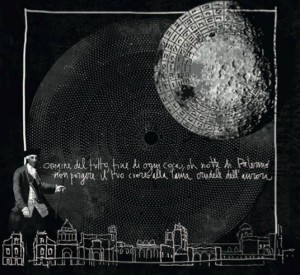
…
Dalla favola teatrale di Vincenzo Consolo
Questo progetto è un omaggio alla memoria del grande scrittore contemporaneo Vincenzo Consolo, di recente scomparso. L’omaggio vuole anche dare seguito all’idea, nata durante un mio incontro con l’autore alcuni anni fa, di uno sviluppo delle potenzialità musicali del racconto. Il racconto, che prende spunto dal frammento lirico “spavento notturno” di Giacomo Leopardi (ma soprattutto, per esplicita ammissione dell’autore, è ispirato dal testo “L’esequie della luna” (1967) del poeta e amico Lucio Piccolo), è ambientato in una Sicilia fantastica, contemplata attraverso un caleidoscopio che combina tutte le tinte del barocco mediterraneo. Sospesa tra narrativa e lirismo, l’intera tessitura del racconto si dispiega quale vera e propria partitura il cui dato musicale scorre sottotraccia come un fiume carsico, emergendo qua e la alla luce del sole (o piuttosto della luna) in occasione di veri e propri episodi melodici e coreutici: canzoni, danze, poesie la cui tensione musicale è esaltata dall’uso di una lingua “personale” dell’autore, che compendia le più antiche radici degli svariati idiomi regionali. E’ dunque proprio la lettura di questa partitura che si è voluta realizzare con questo progetto.
ETTA SCOLLO Mercoledì 3 Dicembre 2014
ETTA SCOLLO
Mercoledì 3 Dicembre 2014
Catania, Cine Tatro Odeon – ore 21.15
ETTA SCOLLO
LUNARIA
Dalla favola teatrale di Vincenzo Consolo
Etta Scollo voce, chitarra
Susanne Paul violoncello
Sebastiano Scollo liuto
Fabio Tricomi mandolino, tiorba, percussioni
Giuliano Scarpinato voce recitante
CORO DOULCE MÉMOIRE
Bruna D’Amico direzione
LUNARIA
Dalla favola teatrale di Vincenzo Consolo
Questo progetto è un omaggio alla memoria del grande scrittore contemporaneo Vincenzo Consolo, di recente scomparso. L’omaggio vuole anche dare seguito all’idea, nata durante un mio incontro con l’autore alcuni anni fa, di uno sviluppo delle potenzialità musicali del racconto. Il racconto, che prende spunto dal frammento lirico “spavento notturno” di Giacomo Leopardi (ma soprattutto, per esplicita ammissione dell’autore, è ispirato dal testo “L’esequie della luna” (1967) del poeta e amico Lucio Piccolo), è ambientato in una Sicilia fantastica, contemplata attraverso un caleidoscopio che combina tutte le tinte del barocco mediterraneo. Sospesa tra narrativa e lirismo, l’intera tessitura del racconto si dispiega quale vera e propria partitura il cui dato musicale scorre sottotraccia come un fiume carsico, emergendo qua e la alla luce del sole (o piuttosto della luna) in occasione di veri e propri episodi melodici e coreutici: canzoni, danze, poesie la cui tensione musicale è esaltata dall’uso di una lingua “personale” dell’autore, che compendia le più antiche radici degli svariati idiomi regionali. E’ dunque proprio la lettura di questa partitura che si è voluta realizzare con questo progetto.
“Lunaria” – intervista a Etta Scollo
Storie dell’Arte : il sorriso
« Tutta l’espressione di quel volto era fissata, per sempre, nell’increspatura sottile, mobile, fuggevole dell’ironia, velo sublime d’aspro pudore con cui gli esseri intelligenti coprono la pietà. »
Il sorriso dell’ ignoto marinaio
« Il Mandralisca si trovò di fronte un uomo con uno strano sorriso sulle labbra. Un sorriso ironico, pungente e nello stesso tempo amaro, di uno che molto sa e molto ha visto, sa del presente e intuisce del futuro; di uno che si difende dal dolore della conoscenza e da un moto continuo di pietà. E gli occhi aveva piccoli e puntuti, sotto l’arco nero delle sopracciglia. Due pieghe gli solcavano il viso duro, agli angoli della bocca, come a chiudere e ancora accentuare quel sorriso. »
Vincenzo Consolo
I luoghi di Vincenzo Consolo, un romanzo per immagini
I luoghi di Vincenzo Consolo, un romanzo per immagini
26 ottobre 2014
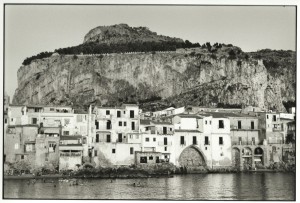
(foto: Carlos Freire – fonte: repubblica.it)
I luoghi letterari di Vincenzo Consolo raccontati dalle immagini del fotografo brasiliano Carlos Freire. Le foto, scattate durante un lungo tour assieme allo scrittore, da Sant’Agata di Palermo a Cefalù, da Pantalica a Palermo, saranno esposte a Parigi, in una galleria di Saint Germain, illustrate dalle didascalie tratte dai romanzi, e faranno poi parte di un libro.
di TANO GULLO, “la Repubblica”, 19 agosto 2014
È la storia di una bella amicizia. Ma anche la testimonianza del percorso letterario di uno dei grandi del Novecento siciliano. Carlos Freire, fotografo di fama internazionale, appassionato lettore di Vincenzo Consolo, prima ha “inseguito” lo scrittore con lettere e telefonate e alla fine, nel luglio del 2006, lo ha conosciuto a Palermo. Da allora non lo ha più mollato. Insieme hanno percorso in lungo e largo la Sicilia soffermandosi nei luoghi dove lo scrittore di Sant’Agata di Militello fa interagire i suoi personaggi. Freire si è innamorato di quella Sicilia vista con gli occhi di Consolo e alla fine ha preso casa a Calascibetta, sul cocuzzolo di fronte a Enna. È iniziato così il suo via vai dalla Sicilia, che continua ancora oggi nonostante il suo amico non ci sia più. Il progetto era quello di pubblicare un libro sugli scenari consoliani.
Tutto era pronto, lo scrittore aveva anche dato il suo placet ai testi e alle foto assemblati da Rosalba Galvagno, ma la morte di Consolo aveva mandato tutto all’aria. Ora quelle foto saranno esposte dal 6 novembre al 7 febbraio 2015 nella prestigiosa galleria “Dina Vierny” a Saint Germain des Près, a Parigi, nel quadro de “Le mois de la photo”, la biennale della fotografia ospitata nella capitale francese, che propone ben ottanta mostre. In seguito l’esposizione si trasferirà a Milano, la seconda città di Consolo.
Sono una cinquantina le immagini di Freire, ma solo in una, scattata a Palermo, c’è ritratto Consolo. «Il protagonista non è l’autore ma il contesto letterario — dice Freire — Consolo parla solo attraverso le didascalie con i brani tratti dai suoi romanzi, che illustreranno la mostra. Le mie foto testimoniano il percorso che insieme abbiamo fatto in un pezzo della Sicilia, quella delle sue opere».
Il libro, invece, vedrà la luce la prossima primavera, dopo la pubblicazione del “Meridiano” Mondadori sull’opera omnia dell’autore de “Il sorriso dell’ignoto marinaio”.
«È stato un privilegio e un dono aver conosciuto Vincenzo Consolo, un uomo di grandissima sensibilità, uno scrittore di enorme acume — dice Carlos Freire, nato a Rio de Janeiro 69 anni fa, naturalizzato francese dove ha fatto base nell’ultimo mezzo secolo in cui ha girato il mondo con la sua macchina fotografica — Quando sono venuto in Sicilia appositamente per conoscerlo è venuto a prendermi all’aeroporto di Palermo con la moglie Caterina e mi ha portato subito a casa sua a Sant’Agata Militello per farmi vedere da dove fosse iniziata la sua avventura umana e culturale. Avermi subito accolto nella sua dimensione intima l’ho considerato un gesto non comune. Poi da lì abbiamo iniziato a percorrere i suoi luoghi. I dintorni del paese natio, e nei giorni successivi Cefalù, dove lui ha ambientato due tra i suoi romanzi più noti: “Il sorriso dell’ignoto marinaio”, la straordinaria storia del barone Mandralisca e “Nottetempo casa per casa”, l’impatto del negromante Aleister Crowley con il perbenismo della cittadina normanna ai tempi del fascismo. Vincenzo era molto legato a Cefalù e ne illustrava abitudini e monumenti. Amava la cattedrale e quell’urbanistica medioevale. E soprattutto quel quadro straordinario del marinaio di Antonello da Messina al museo Mandralisca». Il tour poi prosegue a Palermo dove lo scrittore fa da cicerone allo Spasimo, altro luogo legato a un romanzo, alla Cattedrale, a Monreale. Gli incontri si intensificano e ogni volta si aggiunge una tessera di geografia al mosaico letterario di Consolo. Lo scrittore a raccontare e il fotografo brasiliano a immortalare i luoghi della sua opera. Natura e sentimento.
Il viaggio prosegue a Pantalica e a Messina dove inizia lo spazio “Al di là del faro”. «Era una piacevole abitudine ritrovarci per rimetterci subito in movimento. Siamo così andati a Mistretta, sui Nebrodi, e a Calascibetta, dove ho poi affittato la mia casa siciliana e a Castelbuono sulle Madonie. Siamo andati anche a Racalmuto il paese di Sciascia. Ma lì niente foto. Era il luogo di un altro grande e a me interessavano solo i romanzi di Vincenzo».
Parlavano di letteratura ma anche delle loro vite, un’avventura che in qualche misura li accomunava. «Lui è andato via dalla Sicilia, io dal Brasile. Entrambi esuli volontari. Ognuno di noi con una grande nostalgia della propria terra, ma anche con la consapevolezza che ci sarebbe stato impossibile ritornarvi. Per motivi personali e per la convinzione che tante cose ci tenevano lontano. Lui viveva con il rammarico di una Milano sempre più involgarita negli anni. Ogni tanto diceva che voleva tornare in Sicilia, però si rendeva subito conto che nell’Isola troppe cose non collimavano con la sua visione della vita. Quindi un dilemma tra il volere e il non volere, tra il poter fare e l’impossibilità a fare. E problematiche familiari complesse che non facilitavano la scelta. In qualche modo lo stesso dilemma che vivo io. Per ben otto anni, dalla mia prima emigrazione, non ho fatto ritorno in Brasile. E ancora oggi il mio rifugio è a Parigi. Ecco, è forse per tutto ciò che ci capivamo ».
Il fotografo continua a essere immerso nel mondo di Consolo, sia perché ne percorre sempre le tracce, sia perché le frequentazioni con Caterina, moglie dello scrittore, non si sono mai interrotte.
«Quello che ho cercato di cogliere in Vincenzo è la sua infinita umanità, un’umanità che solo pochi conoscono. Vorrei che i suoi lettori avessero la possibilità di farsi un’idea della sensibilità fuori dal comune di questo grande siciliano. Chi lo ha conosciuto nel profondo ne è rimasto segnato. A Parigi forse era più amato che a casa sua. Marc Fumarolì, il più insigne studioso della letteratura francese del Settecento, che io gli ho fatto conoscere, è rimasto talmente impressionato dalla sua cultura e dalla sua intelligenza che ha voluto rivederlo in Sicilia. Siamo venuti insieme a trovarlo e abbiamo trascorso giornate indimenticabili, cultura e vita vissuta ».
Freire, oltre ad aver fatto numerosi reportage da tutto il mondo — Medio Oriente, India, America latina — ha conosciuto e fotografato il gotha artistico con- temporaneo: Francis Bacon, Warhol, Yourcenar, Cartier Bresson, Amado, Barthes Foucault, Wells e altri, mentre col poeta siriano Adonis ha fatto un libro su Aleppo. Le sue opere sono esposte in musei, gallerie e collezioni europee e americane. «Ho conosciuto tanti numeri uno, ma in pochi ho colto quello sguardo penetrante di Consolo. Ecco, se proprio debbo azzardare un parallelismo, diciamo che un’altra che mi ha colpito in modo particolare è la Yourcenar».
articolo disponibile sul sito de “la Repubblica”
© RIPRODUZIONE RISERVATA
Capire il carattere di un uomo con estrema lucidità attraverso sguardi e parole
 Capire il carattere di un uomo con estrema lucidità attraverso sguardi e parole
Capire il carattere di un uomo con estrema lucidità attraverso sguardi e parole
Destini è un bel titolo: potrebbe funzionare da epigrafe per tutta l’opera di Corrado Stajano (nella foto). Perché Stajano non ha fatto altro, nella sua vita di giornalista-scrittore, che andare a caccia di destini, specie quando i destini individuali si incrociano con quelli collettivi. E questi ritratti che vanno dagli anni Settanta a oggi ne sono la testimonianza più abbagliante. Sono vite che gli stanno molto a cuore: vite di italiani illustri e non illustri che Stajano sa ricostruire grazie alla capacità di ascolto e di osservazione del dettaglio, ma anche alla sensibilità per la visione d’insieme. Nulla gli sfugge, la tonalità di una voce, un gesto, uno sguardo, un oggetto, un capriccio del carattere, la ritrosia di padre David Maria Turoldo nel mettere le scarpe ai suoi «piedoni da gigante», il giaccone foderato d’agnello tanto caro a Peppino Fiori, il buco nel mento di Paolo Volponi, la poltroncina bianca su cui siede il poeta-traduttore Agostino Richelmy. Dal minimo al massimo, la narrazione di Stajano sa allargarsi dalla macro-fotografia al panorama più ampio, storico e naturale: l’incipit del profilo dedicato all’amico Vincenzo Consolo è una sfolgorante descrizione del mare lontano e del paesaggio etneo di vigne «rotto soltanto dai cimiteri di lava nera…». Precisione e limpidezza della scrittura fanno il resto. Non so quanti, giornalisti e/o scrittori, oggi raggiungano queste vette. Leggere i Destini è entrare in una flora fitta di richiami, di connessioni colte ma senza esibizione di cultura e tanto meno di quell’egotismo «brillante» cui siamo abituati; e ciò anche quando la presenza dell’autore-narratore è palpabile, perché tutto è filtrato dalla sua prospettiva mai neutrale e dalla sua partecipazione umana. Le vite individuali così ravvicinate e salvate dall?oblio si saldano con la storia civile italiana del dopoguerra, con gli intrecci di amicizie, solidarietà, inimicizie. Sicché seguiamo la tragica storia di Richelmy e inciampiamo nella voce euforica di Mario Soldati, al fianco di Turoldo troviamo il frate Camillo De Piaz, con Terzani incrociamo Olivetti, Italo Pietra, Mattioli. Un «mondo perduto» che solo la testimonianza di un grande narratore per fortuna può mantenere in vita a futura memoria.
Di Stefano Paolo
(03 ottobre 2014) – Corriere della Sera
Ports as locus of the Mediterranean imaginary Jean-Claude Izzo and Vincenzo Consolo
by
Maria Roberta Vella
In Partial Fulfillment of the Requirements of the Degree of
Master of Arts in Literary Tradition and Popular Culture
August 2014
Faculty of Arts
University of Malta
I dedicate this thesis to you, dear father. You showed me with your constant love, that whatever I do with persistence and commitment will open the doors to my destiny. The long nights I spent awake, reading and researching reminded me of the long nights you spent awake working, pennitting me to study and build my future. Your sacrifices are always accompanied by a constant smile that continuously gives me courage in difficult moments.
ACKNOWLEDGMENTS
The number of people to whom I owe my accomplishments is far too long to fit on this page, as many have inspired me and given me their constant support which has helped me realize that knowledge could open doors I did not even know existed. Nevertheless, there are a number of people who I would like to mention as they have been there for me during tough times and have given me the support I needed. I would like to thank my family without whom I would not have been able to further my studies, my boyfriend Terry, who has always believed in me and has always been there to support me with his constant love, and my uncle Carlo, who from an early age fed me with books and literature that fostered my love of knowledge and the curiosity to find my inner self. I would also like to thank my dearest colleague Ray Cassar, who always helped me grow both academically and as a person, as well as my tutor and mentor Adrian Grima, who directed me, allowing me to ground and express my ideas better whilst always respecting and valuing my opinions.
II
Table of Contents
1 Introduction …………………………………………………………………………………………. 2
1.1 The Harbour as Threshold ………………………………………………………………. 7
1.2 The Port as a Cultural Lighthouse ………………………………………………….. 10
1.3 The Mediterranean Imaginary of Izzo and Consolo Inspired by the Port12
1.4 Conclusion ………………………………………………………………………………….. 16
2 The Harbour as Threshold …………………………………………………………………… 1 7
2.1 Natural Landscape and the Development of Literature …………………….. 20
2.2 Instability vs. Stability in the Mediterranean Harbour ………………………. 23
2.3 The Prototypical Sailor …………………………………………………………………. 27
2.4 The Harbour as a Metaphorical Door ……………………………………………… 34
3 The Port as a Cultural Lighthouse ………………………………………………………… 38
3.1 Religious Cultural Mobility ………………………………………………………….. 43
3.2 The Lingua Franca Mediterranea as a Mode of Communication ………. 49
4 The Mediterranean Imaginary of Jean-Claude Izzo and Vincenzo Consolo
Inspired by the Port ………………………………………………………………………………….. 58
4.1 The Mediterranean Imaginary in Izzo and Consolo ………………………….. 60
4.2 The Mediterranean Imaginary in Popular Culture ……………………………. 69
4.3 Conclusion ………………………………………………………………………………….. 76
5 Conclusion ………………………………………………………………………………………… 78
5.1 The ‘Imaginary’ of the Mediterranean ……………………………………………. 80
5.2 The Mediterranean ‘Imaginary’ Beyond the Harbour ……………………….. 84
6 BIBLIOGRAPHY……………………………………………………………….. .. 9?.
III
Abstract
The Mediterranean harbour is a place of meeting, of encounters between
civilizations, of clashes, wars, destructions, peace; a place where culture comes to live, where art is expressed in various ways and where authors and thinkers have found inspiration in every comer. The harbour imposes a number of thresholds to the person approaching it. This threshold could have different fonns which could be emotional, geographical, spiritual or cultural. Authors such as Jean-Claude Izzo and Vincenzo Consolo lived and experienced the Mediterranean harbour in all its aspects and expressions; their powerful experience resulted in the formation of important images referred to as ‘imaginary’. The Mediterranean imaginary is the vision of various authors who have been able to translate facts and create figures and images that represent a collective, but at the same time singular imagination. The harbour is an important part of the Mediterranean geographical structure and thus it has been the main point of study for many examining the region. Factors such as language have transformed and suited the needs of the harbour, being a cultural melting pot.
1 Introduction
The Mediterranean is represented by chaos, especially in the harbour cities that are witness to the myriad of cultures which meet each and every day to discuss and interact in the harbour. It is imperative to state that chaos, as the very basis of a Mediterranean discourse has been fed through the different voices fonned in the region. These same voices, images and interpretations have found a suitable home in the Mediterranean harbours, places where literature and culture managed to flourish and where the so-called ‘margins’, both geographical and social, found centrality. The harbour has acquired significance in the discourse on the Mediterranean and thus on how literature and cultural expedients and the vaiious authors and artists recall the harbour as an anchorage point for their deep thoughts about the region. 1
Nowadays, the unification of the Mediterranean seems a ‘utopia’, since the Mediterranean is politically perceived as a region full of borders and security plans. One may easily mention the various strategic moves put forward by the European Union to safeguard the northern Mediterranean countries from migration from North African shores. By applying and reinforcing these security plans, the Mediterranean has become ever increasingly a region of borders. It is also important not to idealize the Mediterranean past as a unified past, because the 1 Georges Duby Gli ideali def Mediterraneo, storia, jilosojia e letteratura nella cultura europea
(Mesogea, 2000) pp.80-104
2
region was always characterized by conflict and chaos. Despite the chaos that was always part of the Mediterranean, being a region of clashing civilizations, it managed to produce a mosaic of various cultures that is visible to the eye of the philosopher or the artist. The artist and the philosopher manage to project their thoughts and ambitions for the region; therefore they are able to see hannony in a region that seems so incoherent. The aim of my thesis is to understand why the harbour is crucial in the construction of the Mediterranean imaginary. Both open space and border, the port, as in the case of Alexandria or Istanbul, has for a long time been a center for trade, commerce and interaction. Therefore, it is imperative to focus on the study of the harbour and harbour cities to be able to give substance to a study about the Mediterranean as a complex of imaginaries. The boundaries in the study about the Mediterranean have a special place; in fact a boundary that may be either geographical or political has the ability to project and create very courageous individuals that manage to transgress and go over their limits when facing the ‘other’. In the Mediterranean we perceive that the actual reason for transgressing and overcoming a limit is the need of confonning or confronting the ‘other’, sometimes a powerful ‘other’ able to change and shift ideas, able to transpose or impose cultural traits. Yet, the Mediterranean in its multicultural environment has been able to maintain certain traits that have shaped what it is today. Through movement of people in the region, the Mediterranean has been able to produce a number of great innovations, such as the movement of the Dorians who moved from the south all along the 3 Greek peninsula, and also the ‘sea people’ that came from Asia and, being hungry and thirsty, destroyed whatever they found. The same destruction and movement resulted in the creation of three important factors for the Mediterranean: the creation of currency, the alphabet, and marine navigation as we know it today. The various movements also contributed to the fonnation of the person as a free being with the ability to move freely. Therefore, movement and the overcoming of boundaries in the Mediterranean have contributed greatly to the fonnation of civilization itself.2 A board, today found in the museum of Damascus, with an alphabet very similar to the Latin one written on it, was very useful as it was very simple in its structure. This confirms a high level of democracy, as civilization meant that each individual had the possibility of knowing and understanding what his leaders understood. We get to understand that in the Mediterranean each person can practice his freedom by travelling out at sea and engage in trading. All this was made possible by the same interactions and conflicts raised in the region. Conflicts though are not the only factor that promoted the interaction and the fonnation of interesting cultural and literature in the Mediterranean, as we know it today. Art and culture have been means by which the various conflicts and interactions took life and expressed the deep feelings that inhabited the soul 2 Georges Duby Gli ideali de! Mediterraneo, storia, filosofia e letteratura nella cultura europea (Mesogea,2000) pp. 80-104
4
of the artist. Karl Popper3 states that the cultural mixture alone is not sufficient to put the grounds for a civilization and he gives the example of Pisistratus, a Greek tyrant that ordered to collect and copy all the works of Homer. This made it possible to have a book fair a century later and thus spread the knowledge of Homer. Karl Popper wants to tell us that art and culture have deeply influence the fonnation of a general outset of the region and that the fonnation of the general public is not something that comes naturally, but is rather encouraged. The Greeks in this sense were directly fed the works of Homer by the diffusion of the works themselves. On the other hand, the majority of Greeks already knew how to read and write, further enabling the diffusion of knowledge. Art and architecture are two important factors that have detennined the survival of empires and cultures through time. When artists such as Van Gogh were exposed to the Mediterranean, they expressed art in a different way and when Van Gogh came in contact with the Mediterranean region, the French Riviera and Provence in particular, he discovered a new way of conceiving art. In a letter that Van Gogh wrote to his sister in 1888, he explained that the impact the Mediterranean had on him had changed the way he expressed art itself. He told her that the colours are now brighter, being directly inspired by the nature and passions of the region. The Mediterranean inspired Van Gogh to use a different kind of colour palette. If the art expressed by Van Gogh that is inspired by the Mediterranean is directly 3 Georges Duby Gli ideali del Mediterraneo, storia, jilosofia e letteratura nella cultura europea (Mesogea,2000) pp. 80-104
5 represented and interpreted by the spectator, the region manages to be transposed through the action of art itself.4 The way in which the thesis is structured aims to focus on the vanous images created by poets, popular music and art. Each chapter provides evidence that the harbour has been the centre of attention for the many authors and thinkers who wrote, discussed and painted the Mediterranean. The thesis aims to prove that certain phenomena such as language and religion have contributed to a knit of imaginaries, the layout of certain events such as the ex-voto in the Mediterranean and the use of Sabir or Lingua Franca Mediterranea, which shows how the harbour managed to be the center of events that shaped the cultural heritage of the Mediterranean. The language and religious movement mentioned have left their mark on the Mediterranean countries, especially the harbour cities, which were the first cities encountered. The choice of the harbour cities as the representation and the loci of a Mediterranean imaginary vision is by no means a casual one. In fact, the harbour for many centuries has been the anchorage point not only in the physical sense but also emotionally and philosophically for many authors and thinkers, two of which are Jean-Claude Izzo and Vincenzo Consolo, extensively mentioned in the dissertation. These two authors are relevant for the purpose of this study as they manage to create a vision of the Mediterranean, based on their personal experience and influenced by 4 Georges Duby Gli ideali de! Mediterraneo, storia, jilosojia e letteratura nella cultura europea (Mesogea,2000) pp.43-55
6 the harbour from which they are looking at the region and observing the
Mediterranean. Popular culture ‘texts’ such as movies and music based on the interaction between the person and the Mediterranean region have an important role in the study, as they represent the first encounter with the harbour. It is a known fact that in the postmodern era where technological means have a broader and deeper reach, popular culture has become the first harbour in which many find anchorage. Therefore it would be difficult to mention literature works that have shaped the Mediterranean without mentioning the popular texts that have constructed images about the region that intertwine and fonn a complete and powerful image. The relevance of each factor is well defined in this study, delving deep in not only popular culture but also in language and various historical events that have transformed the Mediterranean, providing examples of how factors such as geographical elements, spirituality, devotion and passion have transfonned the way in which we perceive a region.
1.1 The Harbour as Threshold The first chapter focuses on the harbour as a threshold between stability and instability, between wealth and poverty, between mobility and ilmnobility. The various elements that constitute the harbour always convey a sense of ‘in between’ to the person approaching. The very fact that the harbour seems to be a place of insecurity gives the artists and authors a more stimulating environment to 7 write about their feelings and to contrast them with the ever-changing and chaotic enviromnent of the harbour. The way in which the natural landscape manages to influence the poetic and artistic expression is of great relevance to the study of the Mediterranean region, especially with regards to the study of the harbour. Poets such as Saba and Montale wrote about the way in which nature felt as a personified figure, able to give hope and change the way poets look at the world.
They also wrote about nature in the Mediterranean as being an impmiant feature
shaping the way in which history and culture developed.
The sailor as a representation of a Mediterranean traveller is often found in
literature especially with regards to the notion of the harbour as an image of the
Mediterranean culture. Many authors such as Jean-Claude Izzo and Vincenzo
Consolo wrote about the figure of the sailor in relation to the sea and everyday life in Mediterranean harbours. The novels fl Sorriso dell ‘Ignoto Marinaio by
Vincenzo Consolo and Les Marins Perdus by Jean-Claude Izzo are written in two
different geographical areas of the Mediterranean and reflect two different
periods, but they are tied by an expression of a Meditemm~im i1rn1eirn1ry and
somehow recall common features and aspects of the harbour. Both novels manage to transpose their authors’ personal encounter with the Mediterranean, therefore
recalling their own country of birth. The novels are somewhat personal to the
authors; Consolo recalls Sicily while Izzo often refers to Marseille. The fact that
the novels are projecting two different areas and two different points of view on
8
the Mediterranean proves that by gathering different experiences related to the
region, a rich imaginary is created.
The harbour is a door, an entryway to a new world, and borders. Security
and expectations are all part of the experience of the threshold when entering a
country, especially in the Mediterranean, where thresholds are constantly present and signify a new and exciting experience that leads to a new interpretation of a Mediterranean imaginary. The way in which the harbour acts as an entryway suggests that what lies beyond the harbour is sometimes a mystery to the traveller.
Literature greatly contributes to the fonnation of ideas, especially in regard to the fonnation of thoughts such as the idea of a Mediterranean imaginary, but there is another element of fundamental importance to the formation of ideas on a generic line, which is popular culture. High-culture, referring to elements such as art, literature, philosophy and scholarly writings, creates a common understanding between an educated public. Popular culture refers to the section of culture that has a common understanding between the public. High-culture and popular culture have the power to transform what is mostly regarded as pertaining to high society; literature is constantly being reinterpreted and transfonned by popular culture to be able to reach a greater audience.
9
1.2 The Port as a Cultural Lighthouse The imp01iance of natural landscape which detennines the success or failure of a harbour, also detennines a number of historical events. In this sense, the Mediterranean is a region that has been naturally set up with a number of very important harbours that consequently fonned a particular history. The image of the harbour could be compared to the image of the lighthouse, which is part of the harbour itself but at the same is a distinct entity that in some cases had a role which went beyond its initial role of guidance and assumed almost a function of spiritual assistance. 5 The symbol of the lighthouse is also tied to knowledge and therefore the lighthouse has the ability to give knowledge to the lost traveller at sea, it is able to show the way even in uncertainties. The lighthouses in the Mediterranean had the ability to change through ages and maintain a high historical and cultural meaning; their function is a matter of fact to give direction to the traveller, but in certain cases it has been used to demarcate a border or as a symbol of power.
The Mediterranean Sea has witnessed different exchanges, based on belief,
need and sometimes even based solely on the search of sel£ Among these modes
of exchange and these pretexts of voyage in the Mediterranean, we find the exvoto and the movement of relics. Both types of exchange in the region have in
common at the basis religion that instilled in the traveller a deep wish to follow a
5 Predrag Matvejevic Breviario Mediterraneo (Garzanti: 2010)
10
spiritual path. These exchanges resulted in an increasing cultural exchange. The
ex-voto6 shows a number of things. One of these things is that the very existence
of ex-voto proves a deep connection with the geographical aspect in the
Mediterranean and therefore proving that the region is a dangerous one. In this
sense, people in the Mediterranean have shown their gratitude to God or the
Virgin Mary in the fonn of ex-voto after a difficult voyage at sea. On the other
hand, the ex-voto shows how popular culture mingles with the spiritual experience and the way in which a person expresses gratitude to the divine. The ex-voto paintings have a special way of being identified. The saint or in most cases Virgin Mary, is usually set in a cloud or unattached from the sea in a tempest. Another element that shows if a painting is or is not part of an ex-voto collection, is the acronyms found in the bottom of every painting V.F.G.A (votum facit et gratiam accepit). The use of Latin demonstrates the vicinity to Christianity, whilst the words meaning that ‘I made a vow and I received grace’ prove the tie between the tragedies at sea and the grace given by God. The difficult Mediterranean geographical predisposition, discussed by Femand Braudel7 has developed an abundance of devotion that transformed to shrines and objects of adoration and gratitude. These same shrines, objects and materials that were most of the time exchanged and taken from one place to another, have deeply enriched the Mediterranean with cultural objects and the same shrines are nowadays part of a collective cultural heritage.
6 Joseph Muscat Il-Kwadri ex-voto Martittimi Maltin (Pubblikazzjonijiet Indipendenza, 2003) 7 Fernand Braudel The Mediterranean and the Mediterranean world in the age of Philip II
(Fontana press: 19 8 6)
11
1.3 The Mediterranean Imaginary of Izzo and Consolo Inspired by the
Port The Mediten-anean for Jean-Claude Izzo and Vincenzo Consolo revolves around the idea of a harbour that gives inspiration because it is in essence a border where ideas meet and sometimes find concretization. The Mediterranean harbour for centuries has been a meeting place for people and cultures, thus creating a region full of interactions on different levels. The imaginary for both authors has been shaped by both cultural elements and by the literary elements that find a special place in the mindset of the author. Culture as a popular expression of the concept of the Mediten-anean has developed in different ways, one of which is the projection of the harbour and the Mediterranean itself through media and advertising. Various elements such as the touristic publicity or the actual reportage about the harbour and the Mediten-anean have widened the horizon and the imaginary of the region. In advertisements, the Mediterranean has been idealized in some ways and tends to ignore controversial issues such as ‘migration’; advertising also tends to generalize about the Mediterranean and so mentions elements such as the peaceful and relaxing way of life in the region. Advertisement obviously has its own share in the building of an ‘imaginary’ of the region, but it may also create confusion as to what one can expect of the region. On the other hand, the reportage about the Mediterranean harbour and the region itself focuses more on everyday life in the Mediterranean and common interactions such as encounters with fishennen. Nevertheless, when mentioning 12 the MediteITanean even the reportage at times makes assumptions that try to unite the MediteITanean into an ideal space and it sometimes aims to give an exotic feel to the region. Yet there are a number of informative films that have gathered important material about the MediteITanean, such as the French production Mediteranee Notre Mer a Taus, produced by Yan Arthus-Bertrand for France 2.8 The difference between the usual promotional or adve1iising video clips and the documentary film produced for France 2 was that in the latter the focus points were an expression of the beauty of the whole, whereas in the fonner, beauty usually lies in the common features that for marketing purposes aim to synthesize the image of the Mediterranean for a better understating and a more clear approach to the region. The harbour and other vanous words associated to the concept of the harbour have been used in many different spaces and areas of study to signify many different things other than its original meaning, and this makes us realize that the harbour itself may hold various metaphorical meanings. We have seen the way in which the harbour served as a first spiritual refuge or as an initial salvation point, but it is also interesting to note how the harbour is conceptually seen today,
in an era where globalization has shortened distances and brought down barriers. Nowadays, the harbour is also used as a point of reference in the various technological terms especially in relation to the internet, where the ‘port’ or 8 Yan Arthus-Betrand Mediteranee notre mer a taus (France 2, 2014)
www.yannarthusbertrand.org/ en/films-tv/–mediterranee-notre-mer-a-tous (accessed February,
2014)
13
‘portal’ refers to a point of entry and thus we perceive the main purpose of the harbour as being the first point of entry as is in the context of infonnation technology. The concept of core and periphery has deeply changed in the world of Internet and technology, as the concept of core and periphery almost disappeared. Similarly, the Mediterranean’s core and pe1iphery have always been in a way different from what is considered to be the nonn. Geographically, the core could be seen as the central area, the place where things happen, whereas in the Mediterranean, the periphery acquires almost the function of the core. The harbour is the geographical periphery; neve1iheless, it acquires the function of the core. The islands for example are usually centres, whereas in the Mediterranean they are crossroads rather than real centres of power. In nonnal circumstances the relation between core and periphery is something that denotes not only the geographical location of a place but it usually also refers to economical, social and cultural advancement. Therefore, in the Mediterranean region the concept of geographical centre and economical and social centres are different from their usual intended meaning.
The Mediterranean imaginary has developed in such a way that it
purposely distorted the concepts such as the standard core and periphery or the usual relationship between men and nature or between men and the various borders. In the Mediterranean imaginary, which as we have mentioned is being fed by various authors and popular discourse, has the ability to remain imprinted in our own thoughts and thus has the ability to reinterpret the region itself; we find 14 that the usual conceptions change because they suit not only the region but the author that is writing about the region. The way in which the various authors and artists who describe the Mediterranean are faced with the ongoing challenges presented by the region shows how in essence each and every author has their own personal approach to the region. Their works are essentially a personal project which lead to the enriclunent of the region’s imaginary. The differences between each and every author makes the ‘imaginary’ and the accounts about the Mediterranean much more interesting and ersonalized.
Consolo9 and Izzo10 have different ways of perceiving the region and
although they both aim to create an ‘imaginary’ that may recall similar features, it is undeniable that there are substantial differences in their approach. Consolo on the one hand focuses a lot on the image of Ulysses as a figure that represents him in his voyage in search of the self. Ulysses for Consolo is a figure that manages to preserve a meaning even in the modem era, a figure that is able to travel through time all the while reinventing the Mediterranean. Izzo as well feels that the figure of Ulysses is imperative to the study of the Mediterranean, but he mostly focuses on the impact of the present experience of the region on the conception of a Mediterranean ‘imaginary’ rather than focusing on the past as a representation of the present situation. 9 Vincenzo Consolo Il Sorriso dell’Ignoto Marinaio (Oscar Mondadori: 2012) 10 Jean-Claude Izzo Marinai Perduti (Tascabili e/o: 2010) 15
1.4 Conclusion
The Mediterranean has been seen as a region full of inconsistencies,
contradictions and conflicts, based mainly on the divergent ideas and cultures residing in the same area. The Mediterranean imaginary does not exclude the conflicts that are present in the region and does not aim to unify the region, and in doing so it aims to give voice to the region. For the various authors and thinkers that are mentioned in the thesis, the Mediterranean has transmitted an emotion or has been able to create the right environment to express ideas and fonn thoughts. The relevance of each and every author within the framework of this thesis shows that without analyzing the single expression about the region, through the various works, one cannot fonn an imaginary of the Mediterranean region. The various concepts of borders, thresholds, conflicts and cultural clashes manage to mingle with each other in everyday life in the Mediterranean – greater ideas and fundamental questions find resonance and meaning in simple everyday interaction between a common sailor and a woman at a bar. The Mediterranean in essence is the voyage between the search for deep roots and the analysis of the clashes that result from this search for roots. The study of the Mediterranean is the constant evaluation of boundaries and the search for the ‘self’ through a wholly subjective analysis of the ‘other’. The imaginary plays a fundamental role in bringing near the ‘roots’ and the ‘present’, and the ‘self’ and the ‘other’.
16
2 The Harbour as Threshold The Mediterranean harbour for many authors and thinkers is a starting point as well as a dying point of the so called ‘Mediterranean culture’. In fact many sustain that the ‘MediteITanean culture’ takes place and transfonns itself in its harbours. This concept does not have to confuse us in assuming that a ‘Mediterranean culture’ in its wholesomeness really does exist. There are elements and features that seem to tie us; that the sea so generously brought ashore. On the other hand the same sea has been keeping things well defined and separate. The harbour as the first encounter with land has always maintained an important role in the formation of ideas and collective imagination. The harbour is not selective in who can or cannot approach it and so the fonnation of this collective imagination is a vast one. It is also important to state that the harbour in itself is a place of contradictions, a place where everything and nothing meet. The contrasting elements and the contradictions that reside in Mediterranean ports are of inspiration to the various authors and thinkers who study the Mediterranean. In this sense they have contributed in the formation of this Mediterranean imagination. Literature is an important factor that contributes to a fonnation of a collective imagination; it would be otherwise difficult to analyze the Mediterranean without the help of literature, as the fonnation of a collective imagination was always fed through literature and cultural expedients.
17
The Mediterranean region, as we shall see, is an area that is somehow
constructed; a person in France may not be aware of what a person in Morocco or in Turkey is doing. The concept of a constructed Mediterranean may be tied to the anthropological study conducted by Benedict Anderson 11 where he states that the ‘nation’ is a constructed concept and may serve as a political and somehow economic pretext. The sea is navigated by both tragic boat people and luxurious cruise liners, and these contradictions seem to be legitimized in the Mediterranean region. To give two recent examples we can observe on a political sphere, the European Union’s decision to fonn a Task Force for the Mediterranean (TFM) whose aims are to enhance the security of its shores and to drastically reduce deaths at sea. The TFM is a recent initiative that follows a number of proposals at a political level that have the Mediterranean security at heart. 12 This idea was triggered by a particular event that saw the death of 500 migrants off Lampedusa. It clearly poses a question whether the Mediterranean is a safe place or not, and whether it remains in this sense appealing to touristic and economic investment. The TFM probably reinforces the idea that the Mediterranean is a problematic region and thus requires ongoing ‘security’. To reconnect to the main idea, the TFM reinforces the notion that the Mediterranean is a constructed idea where access from one shore to another is denied and where one shore is treated as a security threat whereas the other shore is treated as an area to be protected or an 11 Benedict Anderson, Imagined communities (Verso, 1996)
12 Brussels, 4.12.2013 COM (2013) 869 Communicationjiwn the commission to the European Parliament and the council on the work of the Task Force Mediterranean 18 area that is unreachable. The contradictions keep on adding up when we see the way the Mediterranean is portrayed for economic and touristic purposes. One example is the ‘Mediterranean port association’ that helps the promotion of cruising in the Mediterranean region providing assistance to tourists who would like to travel in the region. In this context the Mediterranean is used in a positive way in relation to the touristic appeal it may have. The construction of a Mediterranean idea is by no means restricted to an economical or a political discourse; it has deeper roots and meanings that have fonned through a history of relations between countries and of fonnations of literary expedients. For Franco Cassano13, the Mediterranean is a region that in essence is made of differences, it would be otherwise difficult to justify the clashes that have characterized the Mediterranean history, if it was not for the fact that we are all aware that it is a region made up of dissimilarities On the other hand it is due to these dissimilarities that the Mediterranean is an appealing region both for authors and for travelers alike.
13 Franco Cassano,Danilo Zolo L ‘alternativa mediterranea (Milano:Feltrinelli, 2007)
19
2.1 Natural Landscape and the Development of Literature Nature and literature are two elements that intertwine and thus create a collective imagination around the concept of the Mediterranean harbour. In fact, the dialectic between natural landscape and poetic expression was always a matter of great relevance as nature constantly managed to aid the development of poetic expression. The natural landscape helps the fonnation of existential thoughts, such as life, death and the existence of men – thoughts that are always reinterpreted and reinvented through literature. This relation between men and nature was always important in configuring spaces and detennining them according to a common understanding. 14 In the poem of Giacomo Leopardi Dialogo delta Natura e di un Islandese, Nature is personified, and although the indifference and coldness of nature is palpable, we sense that the poet is being aided by nature in fanning his ideas about life itself. Through time and especially through globalization, the world is being interpreted in terms of geographical maps and technology is subsequently narrowing our concept of space and enlarging our concept of life. In the new modem dimension, where the concept of space has acquired an abstract meaning, literature leaves the possibility of dialectic relationship between men and nature, thus enabling men to perceive the places they inhabit as a significant part of their self-construction process. This concept takes us to the perception created around the Mediterranean region and especially the way people look at 14 Massimo Lollini fl Mediterraneo de/la contingenza metafisica di montale all’apertura etica di Saba (Presses Universitaires Paris Quest: 2009) pp.358-372
20
figures such as the sea, the ports and the shores. In Giambattista Vico’s15 poetic geography we understand that the representation of geography through poetic expression is something that dates back in time, through a cosmic representation of senses and feelings. In this regard, Montale and Saba both express in a relatively modem tone the deep representation of the Mediterranean through a mixture of contrasting feelings and ideas. The image of the harbor and any other images in the Mediterranean are deeply felt and analyzed, through the eyes of the poets that live in the region. Montale uses the dialectic of memory to explain his relationship with the Mediterranean, a region locked in its golden age that lives through the memory of poets and authors. He refers to the Mediterranean as ‘Antico ‘ emphasizing the fact that it is an old region. The word ‘Antico ‘ does not merely refer to oldness, but to oldness combined with prestige. The memory characterizes the Mediterranean for Montale, the image of the sea for instance is an archaic image that notwithstanding holds a modem and yet spiritual meaning as it expresses a sense of purification. The sea with its movement brings ashore all the useless and unwanted elements. On the other hand the sea may be seen as a fatherly figure that becomes severe in its actions and makes the poet feel insignificant and intimidated. Montale’s aim was to overcome the threshold between artistic expression and natural landscape through a dialogue with the Mediterranean Sea. This aim was not fulfilled. Montale tried hard to express artistically what the Mediterranean Sea meant but ended his poem humbly putting himself at a lower stage in comparison to the greatness of the Sea. Montale fills 15Massimo Lollini Il Mediterraneo della contingenza metafisica di montale all’apertura etica di Saba (Presses Universitaires Paris Ouest: 2009)
21 his poetry with a mixture of humility and paradoxes; two elements that keep on repeating themselves in the poetry concerning the MeditelTanean.
Furthennore, in Umberto Saba’s ‘Medite1Taneet16 we encounter the same
contrasts and paradoxes used by Montale to develop the figure of the
MeditetTanean Sea. Saba uses the microcosm of Trieste to explain a larger
macrocosm: The MeditetTanean. This technique renders his work more personal and gives it a deeper meaning. Saba and Montale both rely on the memory to express a feeling of deep ties with the element of the sea and the life of the MeditelTanean harbour. Saba’s MeditelTanean resides in his microcosm, personal encounters and experiences fonn his ideas about the region; a region he perceives as being full of fascinating contradictions.
‘Ebbri canti si levano e bestemmie
nell’Osteria suburbana. Qui pure
-penso- e Mediterraneo. E il mio pensiero
all’azzulTo s’inebbria di quel nome.’ 17
‘Drunken songs and curses rise up
in the suburban tavern. Here, too,
I think, is the Mediterranean. And my mind is
drunk with the azure of that name.’ 18
16 Umberto Saba, translated by George Hochfield: Song book the selected poems of Umberto Saba
\V\V\V. worldrepublicofletters.com/excerpts/songbook excerpt.pdf (accessed, July 2014)
17 Massimo Lollini fl Mediterraneo della contingenza metafisica di montale all’apertura etica di Saba (Presses Universitaires Paris Ouest: 2009) pp.358-372
22
Saba mingles his personal classicist fonnation expressed in the ‘all’azzurro’
with the poorest part of the Mediterranean harbour ‘l’osteria’. Both factors are intertwining, and so, the Mediterranean for Saba is the combination of both the richness of classicist thoughts that fonned in the Mediterranean as well as the meager elements that fonned in its po1is; yet they embellish and enrich the concept of the Mediterranean. Saba is searching for his personal identity through the search for a definition to the Mediterranean. In his art he attempts to portray the very heart of the MediteITanean which is found in his abyss of culture and knowledge with the everyday simple life of the harbours. 2.2 Instability vs. Stability in the Mediterranean Harbour In Saba and Montale’s works, the fascinating inconsistencies in the Mediterranean seem to find a suitable place in the ports and in the minds of each and every author and thinker who encounters it. The notion of stability and instability finds its apex in the port. The sea is the synonym of instability, especially in the Mediterranean, being depicted as dangerous and unpredictable. As in the recounts of the Odyssey, the sea, and the Mediterranean as a whole, is a synonym of instability and thus prone to natural catastrophes. The Homeric recounts of Ulysses’ journey explore the Mediterranean that was previously an unknown place. Although the places mentioned by Homer are fictitious, they now 18 Umberto Saba, translated by George Hochfield: Song book the selected poems of Umberto Saba
www.worldrepublicofletters.com/excerpts/song:book _excerpt.pdf (accessed, July 2014)
23
have a general consensus over the definition of the actual places. As time went by historians and authors went on confinning what Homer had depicted in his Odyssey – a Mediterranean that constantly poses a challenge, danger and fascination at the same time. Femand Braudel in his ‘Mediterranean and the Mediterranean world in the age of Philip the II’ 19 sustains the view of a difficult Mediterranean, of a succession of events that have helped the success of the Mediterranean for a period of time. Its instability and complication have not aided the area in maintaining its ‘golden age’. This discourse was reinvented by Horden and Purcell in ‘The Corrupting Sea’20 where the Mediterranean meets geographically, historically and anthropologically. In ‘The Corrupting Sea’ the view of Femand Braudel is expanded into what the Mediterranean meant
geographically and historically, therefore Horden and Purcell explain that the inconsistencies and natural features in the Mediterranean really contributed to bring the ‘golden age’ to an end, but they were the same features that brought on the rich culture around the Mediterranean countries in the first place. Where literature is concerned, the inconsistencies and natural features served as an inspiration to various authors who went on fonning the collective imagination around the Mediterranean. Therefore, it could be argued that the geographical
complexity of the region is in fact the tying point to the ‘Mediterranean’ itself that resides in the unconscious and that otherwise would have died with its economical shift towards other areas of interest. The problematic identity and the challenging 19 Femand Braudel The Mediterranean and the Mediterranean world in the age of Philip II (Fontana press: 1986)
20 Peregring Horden, Nicholas Purcell The Corrupting sea, a study of the Mediterranean histmy (Blackwell publishing: 2011)
24
natural enviromnent brought by an ongomg sense of curiosity and attraction towards the Mediterranean region. The port is the first encounter with stability after a journey that is characterized by instability, at the surprise of the inexperienced traveler. However, the port does not always covey immovability. The p01i gives a sense of limbo to the traveller that has just arrived. It is a safe place on the one hand but on the other hand due to its vicinity to the sea, it is as unpredictable as the sea itself The sailor is a frequent traveler who knows and embraces the sea. He chose or has been forced to love the sea, to accept the sea as his second home. The sailor is in fact the figure that can help us understand the fascination around the Mediterranean and its ports. It is not an unknown factor that sailors and their voyages have captured the attention of many authors that tried extensively to understand the affinity sailors have to the sea. The sailor21 is a man defined by his relation with the sea and is a recurrent figure in a number of literature works all over Europe and the rest of the world. The sailor is the incarnation of the concept of human marginality, he lives in the margin of life and he embraces the marginality of the harbour with the different aspects of the port. The thresholds present in the port are represented by the sailor; a figure that lives between the sea and land, between betrayal and pure love,
between truth and lie. Like the portrayal of Odysseus, the concept of a sailor has 21 Nora Moll Marinai Ignoti,perduti (e nascosti). fl Mediterraneo di Vincenzo Consolo, JeanClaude Izzo e Waciny Lare} (Roma: Bulzoni 2008) pp.94-95
25
infidelic properties. He carnally betrays his loved one, but he is psychologically anchored to one women for his whole life; a women who is always present in various thoughts but at the same time she is always physically distant. As we will see in various works, the sailor is in constant search of knowledge – the very same knowledge that brought him to love and embrace the sea. The knowledge that is conveyed through the action of travelling itself is another question that would require a deep analysis, but for the sake of our study the fact that knowledge is transmitted through the depth of the sea is enough to make a com1ection with the purpose by which the sailor travels. The sailor fluctuates between sea and land, between danger and security, between knowledge and inexperience. The thresholds are constantly overcome by the curious and free spirited sailor that embarks in this voyage to the discovery of his inner-self. The literary voyage of the sailor in the Mediterranean takes a circular route while it goes deep in ancient history and ties it to modem ideas. Since the sailor is not a new character but a recurring one in literature and culture it has the ability to transfonn and create ideas giving new life to the Mediterranean harbours. While the seamen are the link between the high literature and the popular culture, the sailor does not have a specific theme in literature but the archetype of ‘the sailor’ has a deep resonance in many literary themes. As Nora Moll states in one of her studies about the image of the sailor, she puts forward a list of common themes associated with the image of the sailor:
26
‘Tra i complessi tematici, a cm m parte ho gia accem1ato,si
annoverano l’avventura, il viaggio, l’eros, l’adulterio, il ritorno, il
superamento di limiti (interiori) e di sfide ( esterne ), la liberta, la vita
come “navigatio” e come intrigo conflittuale di esperienze. ’22
‘Amongst the complex themes, which I partly already mentioned, we
find adventure, travel, Eros, adultery, the return, the overcoming of
limits (interior) and challenges (exterior), freedom, life as “navigatio”
and as a conflictual intrigue (or scheme) of experiences.’
2.3 The Prototypical Sailor The interesting fact about the study conducted by Nora Moll is that the sailor in her vision is not merely a figure tied to a specific social class, but as we can see the themes listed are themes that can be tied also to the figure of Ulysses. It is difficult to say that Ulysses or the image of the sailor own a predestined set of themes, and in fact they do not necessarily do so. Ulysses is a character that comprehends certain themes, but these change and shift in accordance to space, time and circumstances. What does not change is the thresholds that are always present in the life of a sailor, the limits that are constantly there to be overcome and the external challenges that need to be confronted. The harbour conveys a 22 Nora Moll Marinai Jgnoti,perduti (e nascosti). I! Mediterraneo di Vincenzo Consolo, JeanClaude Izzo e Waciny Larej (Roma: Bulzoni 2008) pp.94-95
27
number of thresholds; as we have seen these are embodied in the figure of the manner. Jean Claude Izzo in his Les Marins Perdus23 wrote about the discomfort of sailors having to forcedly stay on land and their relationship with the harbor, a passing place that has a special meaning. The harbor is in fact a special place for the mariner, as it is the only place where they can have human contact beyond that of the crew. The mariner in Jean Clause Izzo does not feel that he belongs to any nation or country. He belongs to the sea; a sea that managed to give meaning to his life but at the same time managed to destroy it. Jean Claude Izzo uses strong images of the port to describe the tie the sailor has to the harbour itself, he uses sexual and erotic images and ties them to legends and popular culture expedients. The story is interesting because of the way Jean Claude Izzo reverses the way sailors live. In fact he recreates a story where the sailor is trapped in the harbour and so he is forced to view the sea from land and not the other way round as he usually does. The psychological discomfort that Jean Claude Izzo creates portrays the Mediterranean archetypes and the life in the ports from a reverse point of view. Everyday life in the harbour is analyzed through a succession of tragedies that on one hand recall the classicist view of the Mediterranean, and on the other hand, due to references to everyday life elements, may be easily connected to the modem conception of the Mediterranean port. The links created by Jean Claude Izzo are made on purpose to create an ongoing bond between the classic Homeric 23 Jean-Claude Izzo Marinai Perduti (Tascabili e/o: 2010) pp.238
28
Mediterranean and the modem Mediterranean. In fact, Diamantis -the mam character of the novel- is portrayed as a modem Ulysses trying to cope with ongoing temptations and with the constant drive for knowledge. The Odyssey is for Diamantis a point of anchorage. He reads the Odyssey while attempting to define himself: ‘In effetti l’Odissea non ha mai smesso di essere raccontata, da una taverna all’altra,di bar in bar: … e Ulisse e sempre fra noi. La sua eterna giovinezza e nelle storie che continuiamo a raccontarci anche oggi se abbiamo ancora un avvenire nel Mediterraneo e di sicuro li. [ … ]I porti del Mediterraneo … sono delle strade. ’24 ‘Yes … In fact, the Odyssey has constantly been retold, in every tavern
or bar … And Odysseus is still alive among us. Eternally young, in the
stories we tell, even now. If we have a future in the Mediterranean,
that’s where it lies.” [ … ] “The Mediterranean means … routes. Sea
routes and land routes. All joined together. Connecting cities. Large
and small. Cities holding each other by the hand.’ In this quote we see the continuous threshold between space and time being overcome, that serves to keep alive the Mediterranean itself. It is clear that the classic Homeric recount is always reinterpreted and reinvented. The Odyssey
is not the only point of reflection for Diamantis. In fact the protagonist is seen as a 24 Jean-Claude Izzo Marinai Perduti (Tascabili e/o: 2010) pp.238
29
deep character that reflects on the various incidents in his life and it could be argued that Diamantis is the expression of Jean Claude Izzo’s thoughts. The sailors in Jean Claude Izzo’s novel chose to be Mediterranean; naval commerce exists beyond the enclosed sea, but these men chose to sail with inadequate ships in a region where geographical beauty and historical richness meet. The port for Izzo, has multiple meanings and he defines the Mediterranean harbours as differing from other harbours, because of the way they are accessed. Izzo uses the image of the harbour as a representation of love: ‘Vedi, e’ il modo in cui puo essere avvicinato a detenninare la natura di un porto. A detenninarlo veramente [ … ] Il Mediterraneo e’ un mare di prossimita’. ’25
‘You see, it’s the way it can be approached that detennines the nature of
a port. Really detennines it. [ … ] The Mediterranean, a sea of closeness.’
This passage shows the influence of thought, Izzo inherited from
Matvej evic. In fact the approach used to describe the harbour and to depict the nature is very similar to the one used by Matvejevic in his ‘Breviario Mediterraneo’. 26 We perceive that the harbour is substantially a vehicle of devotion, love, passion and Eros, though we may also observe the threshold between the love and passion found in the port and the insecurity and natural brutality that the sea may convey. In this novel, the port is transfonned in a secure 25 Jean-Claude Izzo Marinai Perduti (Tascabili e/o: 2010) ppl22 26 Predrag Matvejevic Breviario Mediterraneo (Garzanti:2010)
30
place whilst the sea is a synonym of tragedy. At the same time the port is seen as a filthy and conupt place. While for Izzo the past is used as a background to tie with the present and moreover to show a link with the future, Consolo uses a different technique. He goes deep in one focal historical point to highlight certain Mediterranean features and problematic issues. Consolo uses the period of time where Sicily was undergoing various political changes. He describes the revolution and the Italian unification, and portrays real events and characters tied to Sicilian history. In Vincenzo Consolo, the image of the sailor is used as a metaphor through the work of Antonello ‘il Sorriso dell’Ignoto Marinaio’.27 The title itself gives us a hint of the tie between art and everyday life. The voices that intertwine and form the discourse around the Mediterranean are hard to distinguish as they have fanned the discourse itself to a point where a voice or an echo is part of another. The work of Consolo28 goes through a particular historical period in Sicily to describe present situations and ongoing paradoxes in the Mediterranean region. It is difficult to resume and give a name and specific allocation to the works on the Mediterranean as the multiple faces and voices have consequently fanned a variety of literature and artistic works. The beauty behind works on the Mediterranean is that archetypes such as the concept of a ‘sailor’ or the ‘harbour’ are revisited and reinterpreted, thus acquiring a deeper meaning and at the same time enriching the meaning of ‘the Mediterranean’ itself.
27 Vincenzo Consolo fl sorriso dell’Jgnoto Marinaio (Oscar Mondadori:2012)
28 Vincenzo Consolo fl sorriso dell’lgnoto Marinaio (Oscar Mondadori:2012)
31
Consolo focuses on the microcosm of Sicily and he portrays a fluctuation
between sea and land. He locates Sicily in an ideal sphere where the thresholds are nonexistent: ‘La Sicilia! La Sicilia! Pareva qualcosa di vaporoso laggiù nell’azzurro tra mare e cielo, me era l’isola santa! ’29 ‘Sicily! Sicily! It seemed something vaporous down there in the blue between sea and sky, but it was the holy island!’ Sicily is placed in an ideal sphere where beautiful natural elements coexist with famine, degradation and war. The imagery created around the island of Sicily may be comparable to the imagery around the Mediterranean region. As for the harbour it is described by Consolo as a place of contradictions, comparable to the ones found in the whole Mediterranean. The detail given to the life in the port is extremely in depth and the type of sentences used expresses the frenetic lifestyle of the port itself: ‘Il San Cristofaro entrava dentro il porto mentre ne uscivano le barche, caicchi e gozzi, coi pescatori ai rami alle corde vele reti lampe sego stoppa feccia, trafficanti con voce urale e con richiami, dentro la barca, tra barca e barca, tra barca e la banchina, affollata di vecchi, di donne e di bambini, urlanti parimenti e agitati [ … ].’30 29 Vincenzo Consolo fl sorriso dell’Jgnoto Marinaio (Oscar Mondadori:2012) pp:56
30 Vincenzo Consolo fl so1-riso dell’Jgnoto Marinaio (Oscar Mondadori:2012) pp:29
32
‘The San Cristoforo sailed into the harbour whilst the boats, caiques
and other fishing boats, sailed out with the fishennen holding the
ropes sails nets tallow oakum lee, traffickers beckoning with an ural
voice, inside the boat, from one boat to another, from one boat to the
quay, crowded with the elderly, women and children, screaming
equally and agitated’ [ … ] The tension around the port is well transmitted in the explanation given by Consolo, there seems to be a point of nothingness and a point of departure at the same time. We perceive that there is plenty of life in the port but at the same time confusion reigns, therefore we could argue that people in ports are not really conscious of life and that they are letting things turn. Nevertheless, the port is the starting point of life that develops either in the sea or inland. Both by Consolo and in Izzo we are made aware of the importance of life at the ‘starting point’, therefore the port in the works of both authors acquires the title of a ‘threshold’ between life and death, consciousness and unconsciousness, love and hatred, nature and artifice, aridity and fertility. In the microcosm described by Consolo, the Sicilian nature and its contradictions seem to recall the ones in the rest of the region. For example, the painting ‘Ignoto Marinaio’ is described as a contradictory painting. In fact, the sailor is seen as an ironic figure that smiles notwithstanding the tragedies he has encountered. The ‘Ignoto Marinaio’ has seen the culture and history of the Mediterranean unveil, he has therefore a strange smile that 33 expresses the deep knowledge acquired through his experience and a deep look that convey all the suffering he has come upon. In the novel by Consolo, the painting serves as a point of reference and in fact, the ‘Ignoto Marinio’ resembles another important character in the novel; Intemodato. Both figures share the ironic and poignant smile and the profound look. Intemodato is seen as a typical Sicilian revolutionary who embraces the sea but at the same time is not psychologically unattached to the situations that happened on land. He is part of the revolution and integral part of the Sicilian history.
2.4 The Harbour as a Metaphorical Door Consolo and Izzo with their accounts of sailors and the life in Mediterranean harbours brought us to the interpretation of the harbour as a metaphorical door. As in the seminal work of Predrag Matvejevic ‘Breviario Mediterraneo’,31 the harbour is tied to the concept of a metaphorical door. In Latin both ‘porto’ and ‘porta’ have the same root and etymological derivation. A harbour in fact is a metaphorical and physical entryway to a country. In the Roman period, the god Portunos was the deity of the harbour who facilitated the marine commerce and the life in the port in general. The various deities related to the sea in the Roman 31 Predrag Matvejevic II Mediterraneo e I ‘Europa, lezioni al college de France e altri saggi (Garzanti elefanti:2008)
34
and Greek traditions are an indication of a deep relation between the figure of the harbour and the physical and geographical figure of the door or entryway. The door may have many different shapes and may divide different spaces but it always signifies a threshold from one point to another. In literature the harbour signifies a metaphorical door between fantasy and reality, history and fiction, love and hatred, war and peace, safety and danger. The image of the door is concretized through the various border controls, visas and migration issues and in this regard the entryway becomes a question of membership. A piece of paper in this case detennines the access through that doorway, but from a cultural and
identity point of view the Mediterranean threshold is overcome through the encounter with history and fiction. Thierry Fabre in his contribution to the book series ‘Rappresentare ii Mediterraneo’; 32 in relation to the Mediterranean identity he states; ” … Non si situa forse proprio nel punto di incorcio tra la storia vera e i testi letterari che danno origine all’immaginario Mediterraneo?”33 ‘ Isn’t perhaps situated exactly at the meeting point between the real stories and the literature texts that give birth to the Mediterranean imagination?’ Fabre is conscious of the fact that the discourse about the Mediterranean limits itself to a constructed imaginary, the poet or artist in general that enters this metaphorical door is expected to conceive the Mediterranean imaginary; blending reality with fiction. The door is not always a static figure but is sometimes blurred and does not 32 Jean Claude Izzo, Thierry Fabre Rappresentare il Mediterraneo, lo sguardo fiwicese (Mesogea: 2000) 33 Ibid (Mesogea: 2000) pp.25
35
clearly divide and distinguish. The Mediterranean itself is a region of unclear lines the fonnation of a port and of a nation itself is sometimes not that clear. In Matvejevic’s ‘Il Mediterraneao e l’Europa’34 literature blends with facts and culture so does the geography around the Mediterranean region: ‘Tra terra e mare, in molti luoghi vi sono dei limiti: un inizio o una
fine, l’immagine o 1 ‘idea che li uniscono o li separano. Numerosi sono
i tratti in cui la terra e il mare s’incontrano senza irregolarita ne rotture,
al punto che non si puo detenninare dove comincia uno o finisce
l’altro.Queste relazioni multiple e reversibili, danno fonna alla costa. ’35
‘Between land and sea, there are limits in many places: a start or a
finish, the image or the idea that joins or separates them. The places
where sea meets land without any irregularities or breaks are
numerous, to the extent that it’s not possible to detennine where one
starts or the other finishes. These multiple and reversible links that
give shape to the coast.’ The coast in this sense is made up of a set of relations between figures and fonns that meet without touching each other, the door is not always present; it sometimes disappears to give room to imagination and the fonnation of literature.
34 Predrag Matvejevic Il Mediterraneo e !’Europa, Lezioni al College de France e Altri Saggi
(Garzanti elefanti: 2008)
35 Ibid (Garzanti: 2008) pp.53
36
The concept of literature allows the analysis of culture and the way it 1s
envisioned and spread through Mediterranean harbours. The fluctuations of varied thoughts that have shaped the Mediterranean imagery through its harbours have no ties with everyday life, if not by the transmission of culture and the means of popular culture that served as a point of anchorage and sometimes as a point of departure for the fonnation of a deeply rooted but also enriching and contested collective imagination.
37
3 The Port as a Cultural Lighthouse The harbour for many centuries has been an anchorage point and a safe place for sailors and travellers that navigate the Mediterranean. We perceive the safety of the harbour as something that is sometimes naturally part of its very makeup, as on such occasions where we encounter natural harbours. In other cases, to suit their needs, people have built around the shores and transfonned paii of the land into an artificial harbour which is able to welcome the foreigner and trade and at the same time to defend if needed the inland. Femand Braudel36 in his The Afediterranean and the Mediterranean World in thP AgP nf Philip TT <liscusse<l the importance of the Mediterranean shores for the traveller in an age when people were already able to explore the outer sea, but yet found it reassuring to travel in a sea where the shore was always in sight. The Mediterranean Sea has always instilled a sense of uncertainty in the traveller, because of its natural instability. Nevertheless, the fact that the shores and ts are always in the vicinity, the Mediterranean traveller is reassured that he can seek refuge whenever needed. The fascinating thing is that the ports in the age delineated by Femand Braudel were not only a means of safety but most of all of communication – a type of economic and cultural c01mnunication that went beyond 36 Fernand Braudel The Mediterranean and the Mediterranean world in the age of Philip II (Fontana press: 19 8 6)
